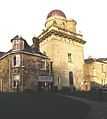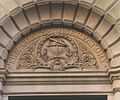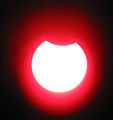Coats Observatory
Coats Observatory is one of Scotland's 4 public observatories.
Coats Observatory is located in Oakshaw Street West, Paisley and was designed by Glasgow architect John Honeyman, with funding coming from local thread manufacturer Thomas Coats. The observatory was operated by the Paisley Philosophical Institution, which had been founded on 8 October 1808. The design incorporates many impressive features of Victorian architecture including wrought iron work from the Saracen Foundry in Possilpark, Glasgow, carvings by John Young and stained glass windows featuring Galileo, Kepler and William Herschel.
The building opened to the public on October 1, 1883. The first telescope was a five inch refractor built by Thomas Cooke of York. Other equipment included an orrery, spectroscope and a transit telescope. Meteorological recording was undertaken on a daily basis, and has continued uninterrupted to the present day.
In 1898 an additional ten inch refracting telescope was purchased, manufactured by Howard Grubb of Dublin. This telescope is still in use at the observatory, as is the original Cooke telescope. That year also saw the addition of a pavilion to the rear of the observatory complex which housed additional astronomical and scientific apparatus and also seismic recording equipment. The pavilion went out of use circa 1930 and was demolished in 1969, but Coats Observatory continued to function as a seismic monitoring station for the British Geological Survey until the nineteen eighties.
Management of the observatory was transferred to Paisley District Council in 1963 and is now operated by Renfrewshire Council Arts and Museums Service.
Coats Observatory is open on a daily basis (except Monday) and runs evening viewing nights throughout the winter months. Renfrewshire Astronomical Society meet there on a Friday evening throughout the year.
Gallery
-

Coats Observatory.
-

Coats Observatory Telescopes.
-

Stained glass window depicting Astronomer Royal William Herschel.
-

Carving above the main entrance to Coats Observatory.
-

Postcard of some of the astronomical equipment at Coats Observatory.
-

Full Moon taken through the 5-inch Cooke refractor at Coats Observatory.
-

Detail of Moon through the 10-inch Grubb telescope at Coats Observatory.
-

Solar Eclipse March 2006 taken at Coats Observatory.
Other public observatories
- City Observatory, Edinburgh
- Airdrie Public Observatory
- Mills Observatory, Dundee
- Scottish Dark Sky Observatory, Dalmellington
External links
- Coats Observatory, local council site
- Coats Observatory, Paisley.org.uk
- Coats Observatory, Aboutbritain.com
- Coats Observatory, Renfrewshire Astronomical Society
- Scottish Dark Sky Observatory
Coordinates: 55°50′44″N 4°25′52″W / 55.845615°N 4.431166°W